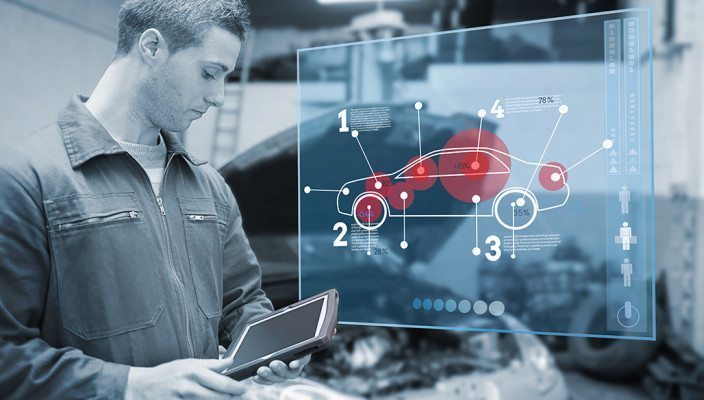Why Field Service Managers Are Talking About Virtual and Augmented Reality
May 25, 2016 • Features • Augmented Reality • Coresystems • Future of FIeld Service
Both virtual reality and augmented reality could have an important place to play in the future of field service writes Manuel Grenacher, CEO of Coresystems...
At this year’s Mobile World Congress, the world’s largest mobile device conference and show, virtual reality and augmented reality were everywhere.
Aside from a photo of Mark Zuckerberg walking amidst a sea of oblivious audience members strapped into VR headsets, companies like Samsung, LG, and HTC were all keen to show off their latest VR gear.
Virtual reality isn’t just for video games. There’s been growing interest in the field service industry on how companies might take advantage of it.
Virtual vs. Augmented Reality
First, however, it’s important to step back and clarify the distinction between virtual reality (VR) and augmented reality (AR).
As their names suggest, virtual reality immerses the user in a completely virtual environment, while augmented reality keeps users in their existing world and simply enhances it.
Deloitte Consulting expects to see VR technologies rapidly adopted by enterprises in the next 18-22 months. And the company specifically cited field service as an industry that stands to benefit from them.
ABI Research makes the case for AR, noting that while virtual reality tends to grab the headlines, AR has one foot that remains in the “real world” and will allow more practical enterprise applications.
The research firm sees 2016 as a turning point for AR smart glasses, predicting that 21 million units of AR smart glasses will be shipped in 2020, with sales expected to reach $100 billion.
Both technologies could have serious benefits for the industry by improving the two key metrics that are important to all field service managers: first time fix rates and average repair time.
They can also benefit staff training and skills shortages.
The Case for VR and AR in Field Service
Field service engineers, wearing a special headset, for example, could be dispatched to a job where they could see the instructions or information about the product directly overlaid on it.
There would be no fumbling for a laptop or tablet; the information they need would be accessible with a flick of their head.
"With such detailed information available, this could even mean that field service companies could dispatch less skilled technicians into the field, while the more experienced engineers could stay at the main headquarters supervising and troubleshooting more difficult issues"
In a pilot project with KSP Steel, a steel mill that produces steel pipelines in Kazakhstan, workers used a smart hardhat to safely access information when they needed it, without having to leave the production line and go back to the control room.
The control room data was projected onto the helmet’s visor, leading to a 40% increase in worker productivity and 50% reduction in factory downtime.
Managing Brain Drain
In an interview first published in Field Service News, Professor Howard Lightfoot of Cranfield University School of Management outlined what he saw as the biggest benefits to augmented and virtual reality tools in field service:
Said Lightfoot, “It could de-skill field service activity. There [are] parts of the world where you can’t get the right people. With augmented reality you can link them to a skilled technician back at the base who can take them through the process. Not with a manual and not on the phone, but he can actually see what they are doing."
"He can overlay information for them and digitally point at things, like: That’s the nut, this is the one you turn. Don’t torque that one anymore than this."
"Torque that one to this level. Undo that cabinet first, and make sure you disconnect this before you do that.”
Moreover, that skilled technician could be “back at base” thousands of kilometers away, reducing the cost of flying specialists out to every complex job.
NTT DATA, the Japan-headquartered telecommunications and IT services company, now uses the Vusix M100 smart glasses to allow continuous, remote monitoring of technicians in the field.
Senior engineers can share the point of view of a technician wearing the M100 Smart Glasses working on-site and can provide immediate instruction in real-time using an overlaid augmented reality marker.
Before using the smart glasses, NTT DATA needed at least two engineers at the work site to ensure quality control, resulting in higher operating costs, a heavier burden for senior engineer staff, and reduced productivity.
Training Techs
"The other benefit of augmented or virtual reality is its potential as a highly detailed, highly visual training tool"
Automobile maker, Ford, has recently added the Oculus Rift virtual reality headset to its virtual reality platforms. It’s used with a shell of a car, where the parts such as the steering wheel and seats can be repositioned to match those of a prototype car. Other field service uses are for training technicians.
By giving engineers the tools to fix problems thoroughly and quickly, you can increase first-time fix rates and lower the average time it takes to fix a product.





















 Field Service News is published by 1927 Media Ltd, an independent publisher whose sole focus is on the field service sector. As such our entire resources are focused on helping drive the field service sector forwards and aiming to best serve our industry through honest, incisive and innovative media coverage of the global field service sector.
Field Service News is published by 1927 Media Ltd, an independent publisher whose sole focus is on the field service sector. As such our entire resources are focused on helping drive the field service sector forwards and aiming to best serve our industry through honest, incisive and innovative media coverage of the global field service sector.
Leave a Reply